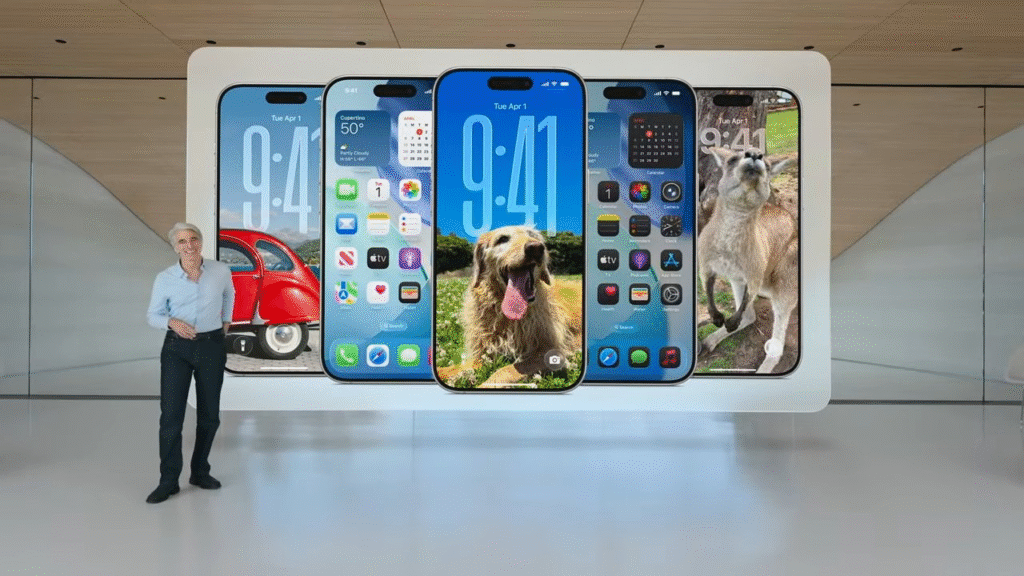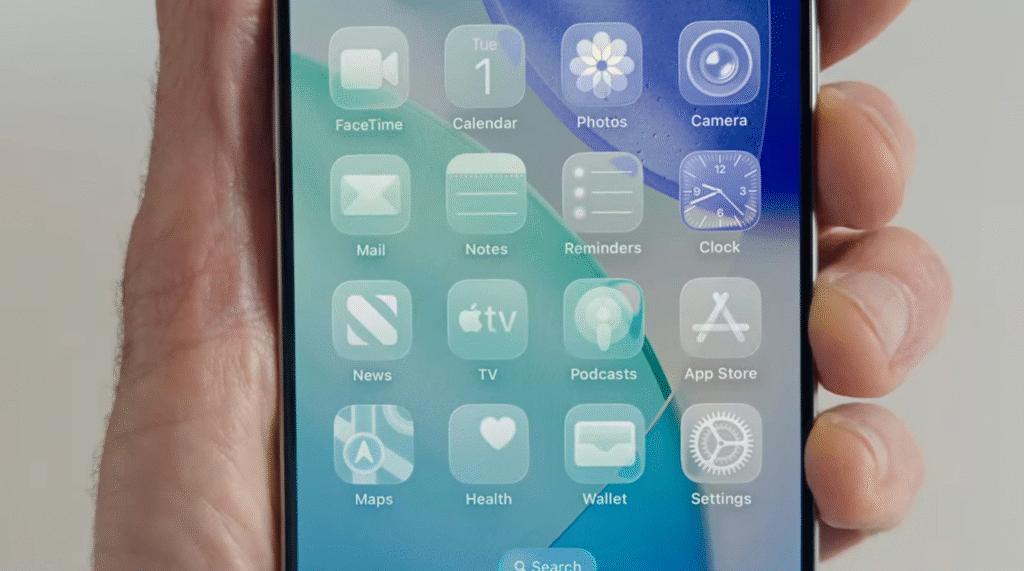Apple has just revealed iOS 26 at its Worldwide Developers Conference. The new release opens a fresh chapter in how iPhone users will interact with their devices. Apple has chosen to name this update after the year rather than following the old number scheme. The goal is to align the operating system version with other Apple platforms and reduce confusion.
Liquid Glass Redesign Across the System
One of the biggest changes in iOS 26 is the Liquid Glass design. This new look adds glossy surfaces to icons and buttons. It makes the entire interface appear as if it were made of clear glass. The light passes through menus and images with a subtle glow at the edges. Wallpapers can now adjust dynamically to lighting and to the time of day. The lock screen shows a new font style that seems to float above the background. When the iPhone is unlocked, the Home Screen icons rest on a slightly frosted surface. This design matches new cues from visionOS and brings a sense of unity to Apple products.

New Camera App with Simple Controls
The Camera app gets a major update in iOS 26. The new interface shows two main modes called Photo and Video. All other controls, such as flash focus and filter,s are hidden behind a top bar. This makes it easier for anyone to take pictures without confusion. Novice photographers will find it quicker to snap a shot. Experts can tap the top bar to choose manual settings and advanced formats. By removing extra buttons from the main screen, Apple aims to keep the focus on the scene in front of the user.
Safari Gets a Full-Screen Experience
Safari also adopts the Liquid Glass style. The address bar and tabs now float above the webpage content. When a user scrolls down, the bars disappear to reveal the full page. Users can bring them back with a single tap at the top of the screen. This full-screen mode makes reading articles and viewing images more immersive. Tabs can be grouped and renamed with a more glass-like look. Users will still swipe between pages, but will delight in the cleaner feel.
FaceTime and Phone Apps Redesigned
FaceTime gains a similar full-screen view during calls. The controls fade out when not in use to allow a clear view of the person on the other end. The call controls appear only when the user taps the screen. The app’s main page also gets new contact posters. Each person can choose a photo or custom image that fills the entire display of their tile.
The Phone app merges recent calls, voicemails, and contacts into one window. This makes it faster to return a missed call. The new Call Screening feature can now answer unknown callers automatically. The phone screen will not ring until the caller gives their name and reason for calling. Users can then choose to accept or reject the call. Hold Assist listens for music in a queue and then reconnects the user when the call finally reaches a human operator.
Messages Adds Polls Translations and Payments
Messages in iOS 26 let users pick a background image for each chat. It also adds the ability to create polls. For example ,users can ask friends to vote on dinner options. Apple Intelligence uses AI to suggest questions for a poll based on the chat topic. Group chats can now request or send Apple Cash. Everyone sees typing indicators when someone is replying. Messages will also detect spam and offer to filter unwanted texts before they reach the inbox. Genmoji AI stickers remain available with new seasonal themes.
Apple Music and Maps Improvements
Music fans can now see translated lyrics on screen. The app shows phonetic guides for the pronunciation of foreign language songs. Automix will blend songs automatically to create a smooth playlist experience.
Maps adds daily commute suggestions by learning a user’s usual routes to work and home. The app also tracks visited places and lets users delete records of locations they prefer to keep private. This helps plan trips and avoid traffic without keeping a permanent log of every stop.
Wallet and Travel Features
Wallet expands its car key support to over twenty new automotive brands, including Porsche. Phone unlocking and remote start functions now work with more car makes. Digital ID cards for travel remain in beta as Apple works with government agencies. A new flight status widget will show gate changes and boarding times on the Home Screen.
New Games App and App Store Updates
Apple introduced a Games app that highlights new releases and lets users browse game trailers all in one place. The App Store will show more editorial content about apps and games to help users find the best options for work and play.
Apple Intelligence Opens to Third-Party Developers
One of the most important changes in iOS 26 is the opening of Apple Intelligence to outside developers. Now, apps can use Apple’s on-device AI models for text editing, image creation, notifications, and more. Third-party apps can call into the same AI that powers system features. Developers will need to follow Apple’s guidelines to protect user data on the device. A new API allows apps to send requests to Apple Intelligence and receive responses all without leaving the app.
Live Translation Across All Apps
Live Translation was once limited to the Translate app. In iOS 26, users can translate text and speech in any app. For example, in a FaceTime call, each participant will see subtitles in their user language. During a phone call, users can enable translation to hear the other person in the chosen language. This works for many common languages at launch, with more to follow.
Visual Intelligence for Screenshots and Camera
Visual Intelligence features move into new areas. When users take a screenshot, a small icon appears. Tapping it lets users search the image or extract key details such as the date and time of an event shown in the picture. Users can also highlight text in a screenshot and copy it to the clipboard or translate it. Visual Intelligence on the camera lets users point the iPhone at an object and search for it online directly from the camera view.

When Will iOS 26 Arrive
Apple plans to release developer betas for iOS 26 this week. Public betas will follow in the coming months. The final public release will occur in the fall around the launch of iPhone 17. Most users will upgrade over the weekend after it goes live. In the months ahead, Apple will fine-tune these features ahead of the widespread rollout.
The Liquid Glass design and new Camera app stand out as major rather than minor updates. Opening Apple Intelligence to developers and expanding Live Translation shows how Apple aims to bring AI deep into daily tasks. Each change points toward a future where iPhones feel more alive and responsive to user needs. Over the next year, as iOS 26 evolves, the community of testers will help polish these changes before they reach everyone.





